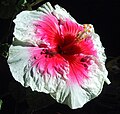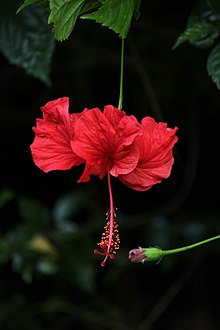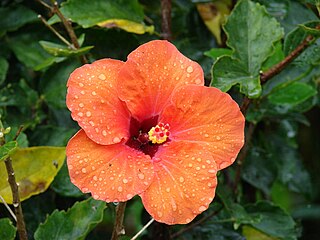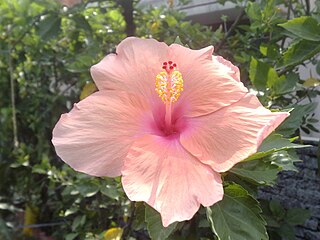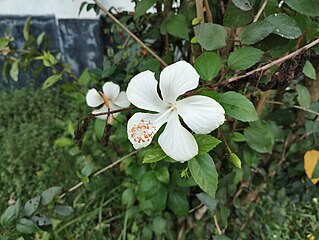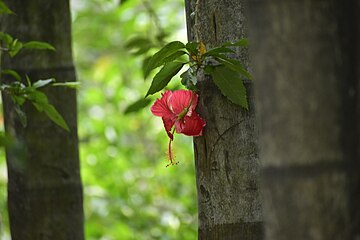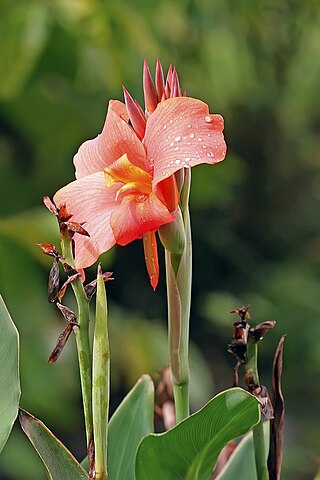
Canna or canna lily is the only genus of flowering plants in the family Cannaceae, consisting of 10 species. All of the genus's species are native to the American tropics and naturalized in Europe, India and Africa in the 1860s. Although they grow native to the tropics, most cultivars have been developed in temperate climates and are easy to grow in most countries of the world, as long as they receive at least 6–8 hours average sunlight during the summer, and are moved to a warm location for the winter. See the Canna cultivar gallery for photographs of Canna cultivars.
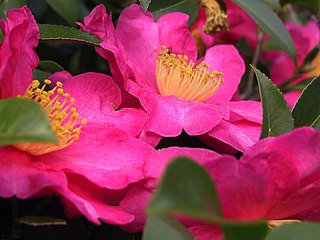
Camellia is a genus of flowering plants in the family Theaceae. They are found in tropical and subtropical areas in eastern and southern Asia, from the Himalayas east to Japan and Indonesia. There are more than 220 described species. Camellias are popular ornamental, tea and woody-oil plants that have been cultivated throughout the world for centuries. To date, over 26,000 cultivars, with more than 51,000 cultivar names including synonyms, have been registered or published.

Hibiscus is a genus of flowering plants in the mallow family, Malvaceae. The genus is quite large, comprising several hundred species that are native to warm temperate, subtropical and tropical regions throughout the world. Member species are renowned for their large, showy flowers and those species are commonly known simply as "hibiscus", or less widely known as rose mallow.

A daylily, day lily or ditch-lily is a flowering plant in the genus Hemerocallis, a member of the family Asphodelaceae, subfamily Hemerocallidoideae, native to Asia. Despite the common name, it is not, in fact, a lily, nor does it specifically grow in ditches. Gardening enthusiasts and horticulturists have long bred Hemerocallis species for their attractive flowers; a select few species of the genus have edible petals, while some are extremely toxic. Thousands of cultivars have been registered by the American Daylily Society, the only internationally recognized registrant according to the International Code of Nomenclature for Cultivated Plants (ICNCP).. The plants are perennial, bulbous plants, whose common name alludes to its flowers, which typically last about a day.

Hibiscus syriacus is a species of flowering plant in the mallow family, Malvaceae. It is native to areas of east Asia, but widely introduced elsewhere, including much of Europe and North America. It was given the epithet syriacus because it had been collected from gardens in Syria. Common names include the rose of Sharon,, Syrian ketmia, shrub althea (or simply althea), and rose mallow. It is the national flower of South Korea and is mentioned in the South Korean national anthem.
Hawaiian hibiscus are seven species of hibiscus native to Hawaii. The yellow hibiscus is Hawaii's state flower. Most commonly grown as ornamental plants in the Hawaiian Islands are the non-native Chinese hibiscus and its numerous hybrids, though the native Hibiscus arnottianus is occasionally planted.
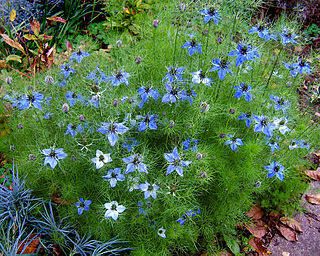
Nigella damascena, love-in-a-mist, or devil in the bush, is an annual garden flowering plant, belonging to the buttercup family Ranunculaceae. It is native to southern Europe, north Africa and southwest Asia, where it is found on neglected, damp patches of land.

Abutilon pictum, syn. Abutilon striatum (disputed), is a species of flowering plant in the family Malvaceae. It is native to southern Brazil, Argentina, Paraguay and Uruguay. The plant has become naturalised in Central America, and is used in horticulture. Common names include redvein abutilon, red vein Indian mallow, redvein flowering maple, Chinese-lantern and red vein Chinese lanterns.

Rosa gallica, the Gallic rose, French rose, or rose of Provins, is a species of flowering plant in the rose family, native to southern and central Europe eastwards to Turkey and the Caucasus. Rosa gallica was one of the first species of rose to be cultivated in central Europe. It is a parent of several important cultivars.
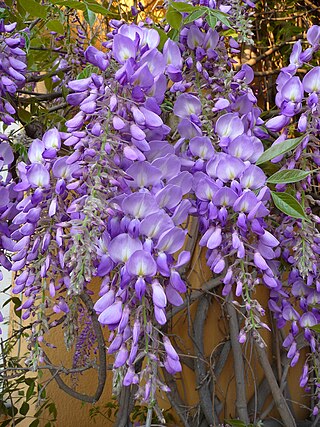
Wisteria sinensis, commonly known as the Chinese wisteria, is a species of flowering plant in the pea family, native to China, in the provinces of Guangxi, Guizhou, Hebei, Henan, Hubei, Shaanxi, and Yunnan. Growing 20–30 m (66–98 ft) tall, it is a deciduous vine. It is widely cultivated in temperate regions for its twisting stems and masses of scented flowers in hanging racemes, in spring.

Camellia japonica, known as common camellia, or Japanese camellia, is a species of Camellia, a flowering plant genus in the family Theaceae. There are thousands of cultivars of C. japonica in cultivation, with many colors and forms of flowers. Despite its common name, it is native to China, not Japan. The cultivation of Camellia japonica also started in China. Its widespread cultivation can be traced back to the Song Dynasty, when 15 varieties of Camellia japonica were recorded in literature. It was later introduced to Japan. It grows in forests, at altitudes of around 300–1,100 metres (980–3,600 ft).
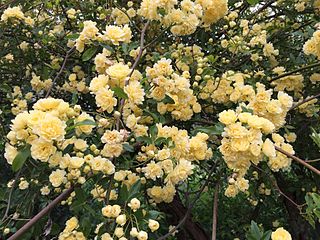
Rosa banksiae, common names Lady Banks' rose, or just Banks' rose, is a species of flowering plant in the rose family, native to central and western China, in the provinces of Gansu, Guizhou, Henan, Hubei, Jiangsu, Sichuan and Yunnan, at altitudes of 500–2,200 m (1,640–7,218 ft). The rose is named for Dorothea Lady Banks, the wife of the botanist Sir Joseph Banks.

Hibiscus moscheutos, the rose mallow, swamp rose-mallow, crimsoneyed rosemallow, or eastern rosemallow, is a species of flowering plant in the family Malvaceae. It is a cold-hardy perennial wetland plant that can grow in large colonies. The hirsute leaves are of variable morphology, but are commonly deltoidal in shape with up to three lobes. It is found in wetlands and along the riverine systems of the eastern United States from Texas to the Atlantic states, its territory extending northward to southern Ontario.

Chaenomeles speciosa, the flowering quince, Chinese quince or Japanese quince, is a thorny deciduous or semi-evergreen shrub native to eastern Asia. It is taller than another commonly cultivated species, C. japonica, usually growing to about 2 m. The flowers are usually red, but may be pink, white or green. The fruit is a fragrant, hard pome that resembles a quince.
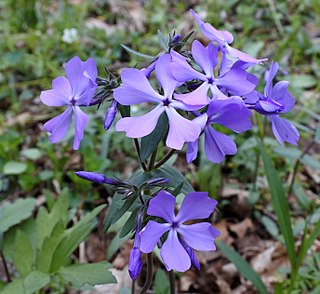
Phlox divaricata, the wild blue phlox, woodland phlox, or wild sweet william, is a species of flowering plant in the family Polemoniaceae, native to forests and fields in eastern North America.
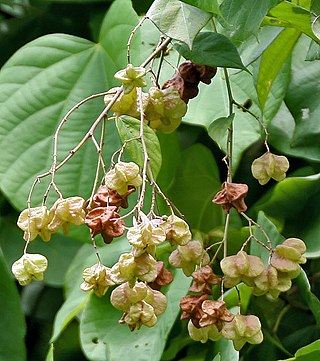
Kleinhovia is a monotypic genus of plants in the cotton, hibiscus and cacao family Malvaceae. The sole species in the genus is Kleinhovia hospita, commonly known as guest tree, an evergreen tree native to Indonesia, Malaysia and other parts of tropical Asia and the Pacific.

Ligustrum ovalifolium, also known as Korean privet, California privet, garden privet, and oval-leaved privet, is a species of flowering plant in the olive family Oleaceae. The species is native to Japan and Korea.

Plumbago auriculata, the Cape leadwort, blue plumbago or Cape plumbago, is a species of flowering plant in the family Plumbaginaceae, native to South Africa and Mozambique.

Hibiscus schizopetalus is a species of Hibiscus native to tropical eastern Africa in Kenya, Tanzania and Mozambique. Its common names include fringed rosemallow, Japanese lantern, coral hibiscus, and spider hibiscus.

In botany, floral morphology is the study of the diversity of forms and structures presented by the flower, which, by definition, is a branch of limited growth that bears the modified leaves responsible for reproduction and protection of the gametes, called floral pieces.


